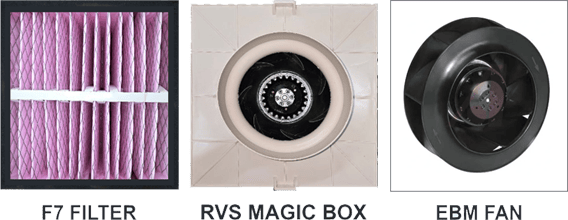Ventilation Systems
Trust RVS Ventilation Systems to turn your damp home into a dry and healthy home
Why ventilation matters
If your windows have condensation in the mornings, it’s a telltale sign that your home isn’t getting enough fresh air. Excess moisture can linger indoors, encouraging mould to take hold on walls, furniture, and clothing—leading to an unhealthy living environment. Our HOME VENTILATION SYSTEM controls moisture inside your home and filters out the nasty pollutants.
Key Benefits
- Reduce humidity, control condensation
- Enjoy a drier and healthier mould free home
- Breathe easy with fresh filtered air
- Increase the life of your home

Whole-Home Ventilation Solutions by RVS
At RVS, we provide comprehensive ventilation systems tailored to the needs of most New Zealand homes. Our solutions are designed to create healthier living environments by reducing excess moisture, improving air quality, and enhancing year-round comfort.
Positive Pressure Ventilation
Our positive pressure systems work by drawing in drier, often warmer air from the roof cavity and gently distributing it throughout your home. This helps flush out moist, stale air and replace it with fresher, drier air—reducing condensation and mould risk. Ideal for older or more ventilated homes, this simple yet effective method improves air quality in the spaces where you eat, sleep, and relax.
Balanced Ventilation Systems
For newer, airtight homes, balanced ventilation is the preferred option. These systems simultaneously supply fresh outdoor air and extract stale indoor air without disrupting your home’s internal pressure. RVS offers advanced systems equipped with Heat Recovery Ventilators (HRVs) or Energy Recovery Ventilators (ERVs) that retain warmth during winter and coolness in summer. The result is a healthier, more energy-efficient indoor climate all year round.
Single-Room Lossnay Systems
We also supply Single-Room Lossnay systems, a compact and energy-efficient option for ventilating individual rooms. Ideal for bedrooms, offices, or spaces without roof access, these systems bring in fresh air while extracting stale air—and recover up to 80% of heat energy in the process. They’re quiet, cost-effective, and perfect for homes where full-system installation isn’t feasible.
Whether you’re renovating, building new, or simply want to improve your indoor air quality, RVS offers tailored ventilation solutions to suit your lifestyle and your home.

Key benefits of using RVS
- Reliable fan: RVS uses the best German technology ebm-papst fans
- Best in Class filter: RVS systems use F7(MERV13) hospital grade filter
- Best Price: Our prices are unbeatable. If you find any prices lower, we will beat it by 5%
- Best in class electronics: RVS uses the best electronic components in the design of an RVS system
- Best in class Air diffusers: Our diffusers are multi directional and made from discolour proof and fade proof ABS so they still look good years later
- Product warranty: We give you a 5 year warranty* as we trust our products and our installation team.

Installing your RVS system
After we measure and evaluate your home, we’ll custom-craft an RVS ventilation system tailored to your space.
A RVS specialist will arrange a convenient time for the work to begin and the team will discuss with you the best positions for both the control panel and the ceiling vents to maximise the effect and efficiency that will help reduce the condensation and keep your home drier, in most cases, installation is completed in a single day, although larger or more complex properties may require additional time. Once the system is up and running, the RVS team will demonstrate how to configure and operate it to keep your home fresh and dry.

Key Features
- RVS Control Panel: RVS uses Intelligent digital controllers that are fully automated.
- RVS ceiling vents: The vents are 150mm round – These inconspicuous vents compliment any décor and these help to direct airflow where it is needed.. Within couple of days, your system will be ready for installation.
- RVS Filters: The filters help to filter out pollen and other impurities from the home. These hospital grade F7 filters are also treated with anti-microbial agents to destroy pollutants on contact.
- Fire Retardant Ducting: RVS ducting is custom designed and installed in your house and is made up of materials that withstand the temperature extremes found in your roof ensuring a very long life.


RVS Control Pane
RVS uses Intelligent digital controllers that are fully automated.

RVS ceiling vents
The vents are 150mm round – These inconspicuous vents compliment any décor and these help to direct airflow where it is needed.. Within couple of days, your system will be ready for installation.

RVS Filters
The filters help to filter out pollen and other impurities from the home. These hospital grade F7 filters are also treated with anti-microbial agents to destroy pollutants on contact.

Fire Retardant Ducting
RVS ducting is custom designed and installed in your house and is made up of materials that withstand the temperature extremes found in your roof ensuring a very long life.



